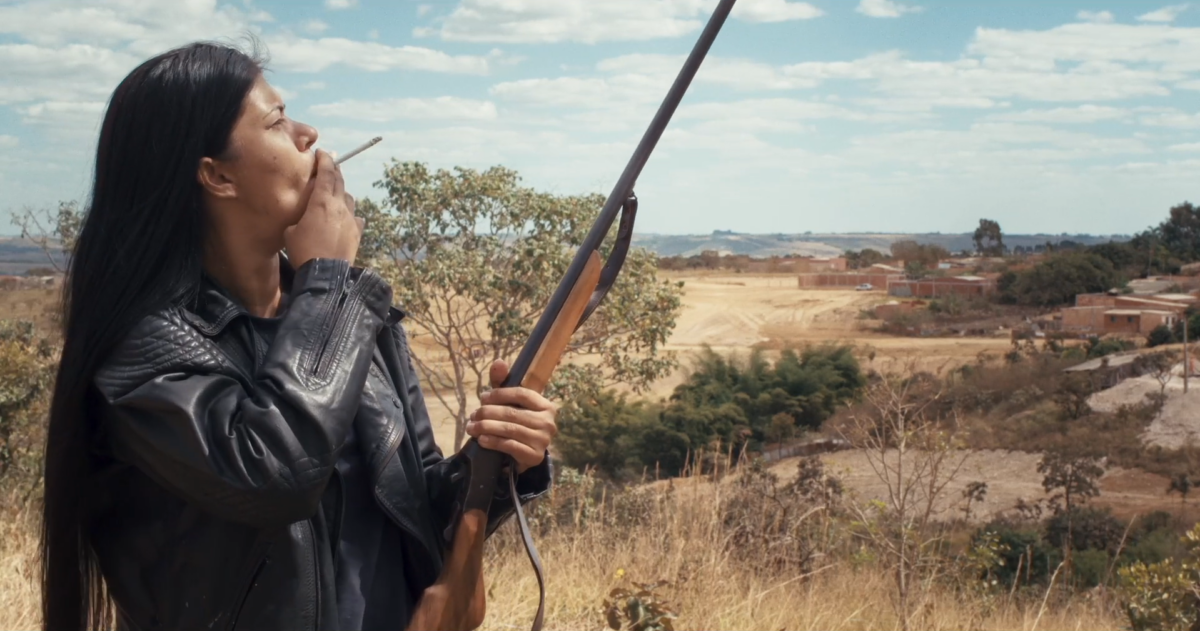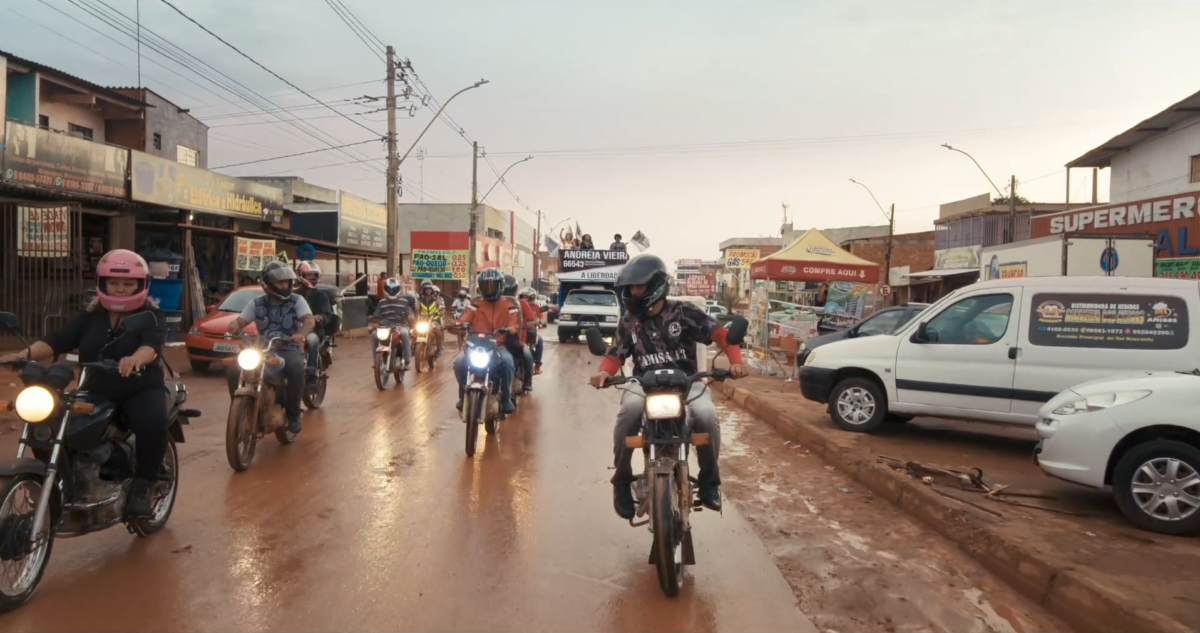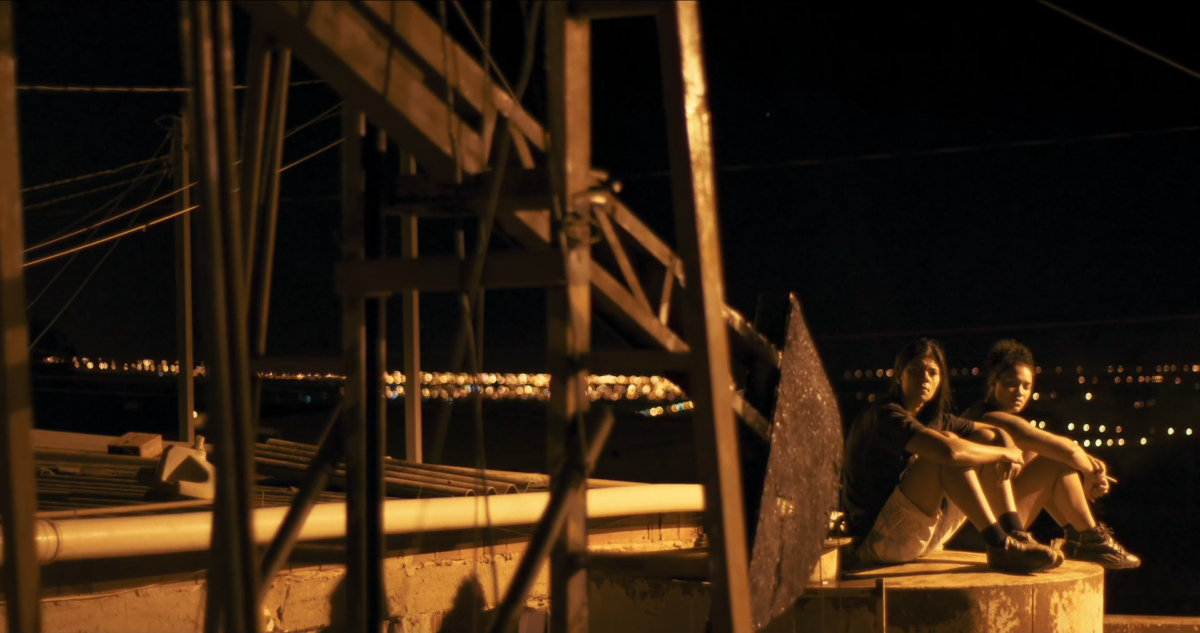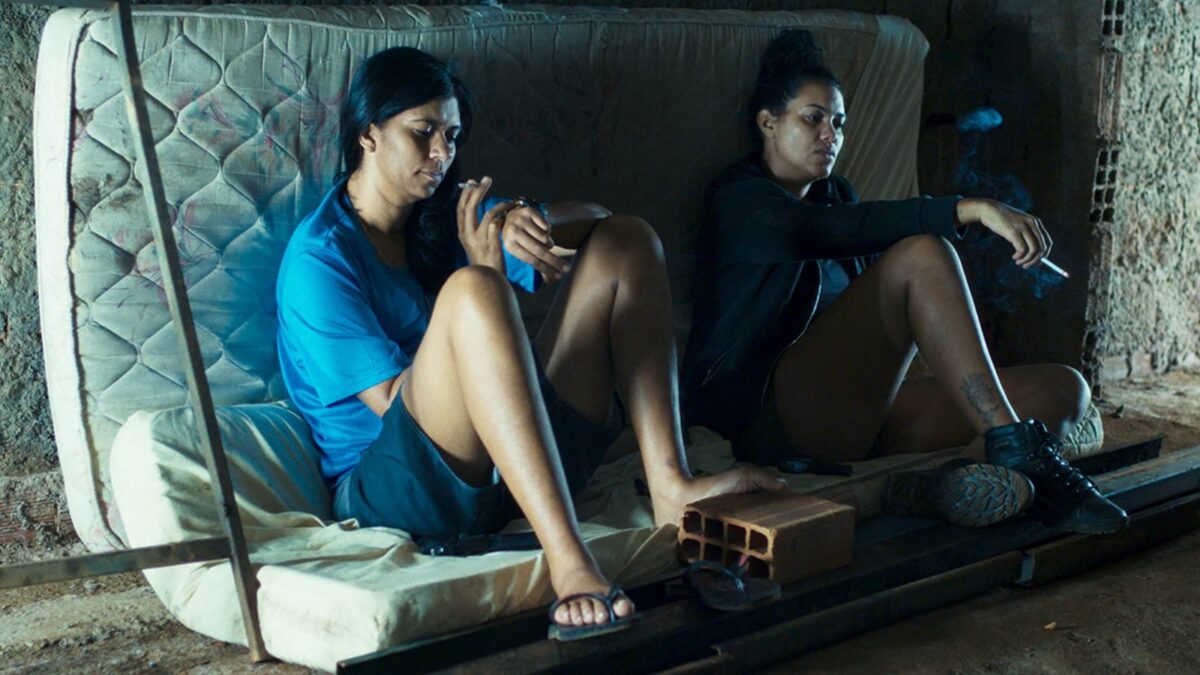In his song, Tropicália, Caetano Veloso leads a whirlwind tour of the Brazilian topography and psyche. What he finds and then transmutes is varyingly energising, absurd, grotesque, and tragic, a modern Brazil transported along on the feet and heads of planes, trucks and carnival, fuelled by the vitalizing ichor of samba and bossa nova. He evokes various figures and locales, from Iracema, author José Martiniano de Alencar’s Romantic, fantasy vision of a Brazilian Eve, to Carmen Miranda, a Portuguese-born, mid-century ambassador of Brazilian music, and in many’s eyes an exoticised, American product masquerading as a national symbol, as a singer and star on Broadway and in Hollywood. There’s an outburst of regionalist pride, with a hail towards Bahia, home to the original capital of Salvador but also a state, with a strong independent and dissident identity, with its mainly working-class, black and brown population, a long history of attempted, utopian rebellion, and a revolutionary wellspring of music—the majority of those musicians associated with the Tropicália movement, Veloso included, are Baianos. The most pronounced recurring image in the song is that of “o monumento no planalto central”, Brazil’s new capital of Brasilia, constructed between 1956 and 1961, as the epitome of a certain Brazilian exceptionalism, of a land of “three races” made one by a unifying dream. The model of a modern nation as a multi-racial, multi-ethnic politic built upon a cultural ‘carte blanche’ on a territorial ‘blank slate’.
Brazilia was erected in the interior, to give the country a more central, and therefore inclusive, metropole, with the adventurist architect Oscar Niemeyer commissioned to design and shape the city according to a new, distinctly Brazilian modernism. And yet the project would very quickly shed its utopian skin, with workers exploited and abused throughout its expedited construction, and the majority of this new nation having to bear the brunt of foreign loans that funded it. Although Niemeyer, who had ties with the Communist Party, designed the city with a certain degree of non-hierarchy in mind—with residences around the same size and a lot of wide open, public spaces—the capital quickly became, and remains, a stark illustration of inequality, with the shiny, circumscribed Brasilia ‘proper’ serving as the throne and playground for a largely white and wealthy elite. The majority of the Federal District’s disproportionately impoverished black and brown residents live in its orbit, in vast, improvised city-sized suburbs, often only entering the centre to be exploited further as service workers.
Adirley Queirós has become one cinema’s great observers and counterforces to this dystopian arrangement. He was born and raised in the Federal District’s largest division, Ceilândia, which bears the scars of this calculated racist and classist segregation in its very name. The first syllable comes from the initials CEI, Campanha de Erradicação de Invasões or Invasions Eradication Campaign, a government initiative in the 70s to halt the growth of Brasíla by hemming poor migrants in at its boundary in new, hastily built, and insufficient housing.
Since 2005, Queirós has stuck to his home turf and developed a film praxis composed of an ambitious medley. His cinema is a distinctive mix of fictionalized and documentary elements, genre frameworks and symbols and moments of direct address and militant appeal, dedicated to unspooling this history, and present tense, of exploitation and not only centred on the people of these neglected communities, but co-authored by them as well. The films are about systemised dystopia and spontaneous, or otherwise ad-libbed, utopias and how urbanity can not only be the tool and brutal endpoint of top-down injustice, but a stage for unbridled underclass expression.
Queirós’s bricolage approach emerged out of a desire to make a counter-cinema, aligned with the people of his hometown against those in power, but also out of frustration with the moralising ‘political correctness’ of the most conventional forms of protest through cinema: the socially conscious and advocacy-minded documentary or drama. Where often in the name of doing things the ‘right way’, whether that would be ethically or in terms of technique, all too conveniently fit their disenfranchised subjects into pre-conceived boxes. They harp on destituteness, and in the process shave off those tangents and a sense of imagination which are just as integral. Queirós then wanted to make an “attempt at a sort of terrorist cinema” against both the authorities and those pedlars of “misery porn”. He found taking the framework of a film like Blade Runner and melding it with real people, situations, and history, freed himself, the people on-screen and the spectator from those diminished expectations engendered by the state and conventional non-fiction form alike. This was doubled down with his third feature, Once There Was Brasilia (2017) about a time-traveller sent back to assassinate the Brasilia-inaugurating President Juscelino Kubitschek, only to be stranded in 2011 during the impeachment of Dilma Rousseff and the rise of Jair Bolsonaro.
It marked a new, transformative collaboration, for it was shot by the filmmaker Joana Pimenta, who has encouraged this more imaginative approach as well as bringing a new sensuous, often night-drenched visual style. They’re two artists from very different backgrounds and initial beginnings. Queirós came to cinema relatively late, after a decade as a professional footballer, and his expansive conception and form of cinema stemmed from a microcosm, a particular place, and grassroots impulse. Pimenta is Portuguese, her work, as a filmmaker and an academic, has not been limited to a few neighbourhoods but dispersed across the globe, to Portugal, Brazil and the U.S.. She has also closer ties with the often less freeform world of academia. However, within that mode, she has found her own radical ties and expression, such as an association with Harvard’s Sensory Ethnographic Lab. Their influence can be detected in both her own, solo-directed short films and her work with Qúeiros, in their emphasis of texture and gesture as a powerful site of meaning, over a clearly dictated narrative or laid-out conclusions, and a subversive reconciliation of the ethnographer’s distance with formal and genre play.
Dry Ground Burning (2022) is their second collaboration, the first they’ve co-directed and their most large-scale work, made over a period of five years and coming in at around two and half hours, following on from shorts and features in the sixty to eighty minute range. Its montage of forms and effects, is a chimera that imbibes, cycles between and overlays a ethnographic record, a militant documentary, an urban legend, a gangster film, music videos and even has some hints of science fiction.

The setting is Sol Nascente, a neighbourhood on the fringes of Ceilândia, and the governing force is three women. Two of them, Chitara and Léa, are paternal half-sisters— their father, Lasquiera, was a semi-legendary figure, long dead before the events of film, whose lawless and womanising spirit lives on, mostly or even solidly in Léa. We’re told she’s his spitting image, and she seems to have inherited much of his braggadocio, as well as his sex life, for she’s an out and proud queer character, confidently bragging about her rotating prison harem and her brothel routine. On the other hand, Chitara is a cooler, more self-contained personality but with a no less powerful presence. A person of quiet confidence, and clearly capable of violence when pushed, she opens up less than the more extroverted Lea but in her own way, speaks just as voluminously. The third woman is Andreia, who also appears in Once There Was a Brasilia. Like Léa, she’s an ex-con, whose experiences have led her to form the Prison People’s Party, a left-wing, populist movement. We see her give rousing campaign speeches in settings that match her position’s liveliness and anti-establishment thrust, live-streaming while hitching a ride on the back of a motorbike going full throttle—delivery driver seems to be the most common and reliable form of occupation in this neighbourhood, but one that is punishingly bureaucratised—or broadcasting from a party truck (party in both senses of the term).
What brings these three women together, beyond family and friendship, is business of a rebellious nature. They are latter-day cangaceiras, or rather, gasolineiras, for together they operate a hijacked pipeline and petroleum processing plant, which Chitara discovered and founded on the outskirts of the outskirts. They then sell the petrol on the cheap to the beleaguered motos, undercutting the state and privately-owned companies. It’s no wonder then that they are under surveillance.
This plot introduction that I’ve given is both accurate and far too neat, for it’s a film preoccupied less with narrative than with mood, presence, character and landscape, and set on a non-linear path with many ellipses.
This circuitness is baked into its foundations. Rather than being a fiction iron-cast with trained actors and a set script or a documentary embarked on a preconceived mold to which people are position and cut, Queirós and Pimenta made the film over the five years in close collaboration with Chitara, Léa, Andreia and others, who are both being and playing themselves. This resultant chimeric work could then drastically change on a short notice. For instance, during a Q&A at the film’s Berlinale premiere, the filmmakers said they originally planned to focus mainly on Chitara, for Léa was in prison during the initial filming. Once she was released and her bombastic presence was made evident, production changed course accordingly. It’s a form of filmmaking that eschews the delineated production stages and stricter hierarchy of industrial filmmaking, over an atmosphere of constant, collective revision undertaken “in a spirit of adventure”.
Though they can and do handle weaponry and cut deals, a great majority of the film is not occupied by the kind of action that typifies a gangster film or the western (American and cangaceiro), of which the genre aspect evokes. The focus is on lengthy scenes of sheer work, hanging out and other things that preoccupy the characters’ time, from Chitara checking in on her mother to Andreia attending an evangelical service. The emphasis on wordless presence and action, of the attentive recording of these personages’ actions and gestures, without any overt editorialising, combined with the growing awareness of fictional or specifically genre elements, reminds of how Sergei Eisenstein took his interpretation of the Kabuki techniques of ‘aragoto’, a stylized acting style based on a set range of ‘kata’, or forms, and ‘mien’, the emphatic, fourth-wall breaking introduction of a character where they perform their signature, role-identifying kata to the audience, and applied them not to the stage and trained performers but proletarian non-actors and real locations, in order to create a new kind of ecstatic-realist acting. Pimenta and Queiróshave found that the ethnographic method of close but distant observation can not only be made commensurate but varingly heightened and playfully chopped and screwed along with the visceral yet imaginative play of genre-cinema and popular aesthetics. Such as how the sisters’ sorrows are commentated and countered with the kabuki-like, in its upfront stylization, aspirational brio of cinematic and rap-video gangsterism, evoked in the bouts of hard-boiled action, stances and one musical sequence where Léa moves through town flanked by a motorcycle entourage.
The rhythms of the sisters’ graft and their day-to-day keep time for the transformational power of music itself, perhaps the film’s most powerful avenue of expression. Instead of a score, the filmmakers employ a wide array of needledrops, for the most part diegetic. While the film’s litany of bodies at work generally express a tug of war between the demands of the system and their own aspirations, their bodies at dance, singing or otherwise caught up in a tune, dispel any totalitarian chains and reveal themselves and their desires more powerfully than words. From small but potent instances, like an early scene of Léa caught up in a kind of work song, rapping away herself as she stands guard, rifle in hand, over the pipeline, to Andreia’s prominent use of music in her campaigning.

One of the most notable aspects is the considerable amount of rap, baile funk and other offshoots present. Baile funk is a hard and fast form of dance music, drawing from high-tempo forms of hip hop like miami bass, which first bubbled up in Rio de Janeiro and at favela parties in the 90s and has been a popular genre ever since. But despite its popularity, it has a contentious, public record. It’s a genre of the working class and so condemned, like rap and grime, by conservative forces for its violent and sexual lyrics and frequently banned from official radio play. It has grown then, ad hoc, from party to party and through the internet, and in the process been married to a myriad of other genres and been given a multitude of unique spins.
Charismatic Christianity is also a significant strand of working class Brazilian life, in recent decades especially, though imbued with far less equalitarian prospects with its strong association with the right. In the Paula Gaitán film, Riverock (2020), the musician Leonardo Campelo Gonçalves, aka Negro Leo, another iconoclastic and pick-’n-mix artist, compares the origins of this growing popularity of pentecostalism and evangelism in Brazil, imported by visiting American preachers and buoyed by powerful conservative forces, with the bottom-up birth of Afro-Brazilian religions such as candomblé. Gonçalves also criticises the secular left’s methods of countering this reactionary religiosity, with their point-blank condemnation and mockery, displaying a certain bourgeois distaste for spirituality and a blind overconfidence in secular reason. He suggests insteads embracing religion and challenging these forces on “the battlefield of the text itself”.
He was talking about the biblical text but the implication is that artistic texts can be a powerful front too. Queirós and Pimenta seem to be on the same wavelength with their inclusion of a lengthy, bracing scene of an evangelical service. The appeal of this kind of religion; the powerful sense of both personal exorcism and communal belonging, achieved through the musical, decentralised gusto of their services rather than the heavily co-ordinated, recital of a dry liturgy, is not denied, but it since pivots around the most overtly root-and-branch political character, it’s re-appropriated by and not just for the people. It’s comparable to a scene with Léa and several women on a party bus, bumping, grinding and making out to a macho baile funk track about a threesome in a helicopter, transforming into a lesbian aphrodisiac.
The scenes that are driven more by speech often unfold the film’s narrative— they are overtly tied to a more recognisable documentary form, and yet their purpose within the larger film is unique. Léa and Chitara occasionally speak about their lives, their pasts, and beliefs, in a monologue form, to an off-screen and unheard personage. These moments, pronouncedly didactic in contrast to the rest of the film, which can occasionally border on the gnomic, are a powerful attempt to repurpose documentary narrative of the kind which Queirós has stated,by giving back these subjects their subjecthood. For it not only gives room for Léa and Chitara to account for themselves and their lives on their own terms but fleshes out the rest of the film, where their ‘performances’ are not just shaped by themselves but in a complex, evolving relationship to others, to a place, the powers that be and genre expectations. These monologues can then be viewed as the film’s loci; the grounding, structuring but still ambiguous moments in lieu of a more reductive approach such as clear-cut voiceover or more directive, driving editing, out of which the scenes of their un-commentated reality, gasolineira-genre allegory and outside perspectives on their lives orbit and push away.

Queirós and Pimenta pay near as much attention to landscape as they do to the lives which they support and direct. In a fashion closer to Straub/Huillet’s Too Early/Too Late (1981) than in what is common in genre cinema or conventional documentary, Dry Ground Burning exudes a sense of place that is remarkably communicative about the history and the wider social implications of the spaces seen on-screen. The ad hoc oil facility is a compound of swirling smoke and noise, sweat and oil stains, ringed in by fences and observation posts and centred around a derrick, which pumps like a heart and whose bowing and animal-like groaning recalls Cormac McCarthy’s own description of a derrick as a “great mechanical bird”. It is defined emphatically by the filmmakers as a living ecosystem whose lifeforce is the minute-by-minute labour of these women. The sheer strength required to master the machinery is clear, and the close-ups of the fruits of their work, the oil, which is churned like pitch-black caramel, is deeply sensuous—“that’s good-looking oil” is the first line of dialogue.
The women’s labour is at the forefront, the central action, while state power subverted but undeniable present, is a poltergeist, largely invisible but suffocatingly entrenched, intrusive and destructive. Early on, Léa, fresh out of prison, comes across the inverse of the gasolineiras’ keep. An enormous blasted heath, where there was once a neighbourhood. It was a place that she viewed with love, where life and joy flourished amidst hardships, but which the authorities viewed as out of control and criminal. She is told that it’s now the site of a future prison, with many of the uprooted residents having been sentenced to ‘mandatory labour’ on its construction. When the authorities do physically materialise it is an suffocatingly sterile, unified form, from the recurring appearance of a police riot van whose armed to the teeth occupants look comically cramped within its confines. They are supposedly comrades, stuck in close quarters, and yet there’s no rapport, no banter, only a dead silence interrupted occasionally by gunfire and a mechanical fascist catechism.
The palpable absence of men, who generally appear as side characters, as supportive friends, clients or the authorities, combined with off-screen presences of much-talked about male figures, the deceased Lasqueira and Léa’s beloved son, Guillerhme, who’s serving a prison sentence, can be read in two ways: as a factor behind this women-led utopia, but also as a result of the havoc wreaked by the state on these communities, with the women left to salvage the ruins. Yet this omnipresent, phantom power can also be subverted. Drones hover around the oil facility, casting a net of constant surveillance, but Léa and Chitara counter with a laconic attitude and sense of humour, by imagining that the drone is a UFO that Léa will hijack and soar out of the clutches of power’s reach.

Dry Ground Burning’s daring, to chop and screw so many forms and elements often deemed disparate, even contradictory, could be traced back to a wide and rich strand of Brazilian modernism. It originates, at least as an explicit, riotous statement, back in the 1920s, the corpus of the collective Grupo dos Cinco and specifically its member, the omnivorous writer Oswald de Andrade’s Manifesto Antropófago or Anthropophagic Manifesto. It poetically advocated for Brazilian art to embrace a “cultural cannibalism”, a provocative heterogeneity, in the face of crushingly unified and dictatorial European colonialist culture.
Anthropophagic Manifesto has been invoked by many subsequent Brazilian movements, most concentratedly in the creative hotbed of the late 60s and early 70s. It influenced many of the musicians associated with Tropicália, who had their detractors across mainly on the right but on left too with their mixing of popular British and American music, along with Brazilian and avant-garde methods, getting them frequently dismissed as decadent and kitschy. These charges, in anthropophagic fashion, they would embrace and reuse, with Veloso’s love of Vicente Celestino, whose operatic, sentimental songs were considered overblown and out-of-date by many critics in the late 60s, pushing him to record a cover of Celestino’s Coração materno for the group manifesto record, Tropicália: ou Panis et Circencis (1967). The record also includes a Gal Costa sung version of the Veloso-penned tune, Baby. It’s perhaps the movement’s most popular arrangement, and a playful dig at both the supposed sincerity of love songs and the capitalist American interest-driven expansion of English, with the demand for a declaration of love, national identity and the headiness of modern life being responded with the pithy, pop art sigh “Não sei, leia na minha camisa” (“I don’t know, read it on my shirt”).
Many anthropophagist ideas can be found in a cinema movement contemporary to Trópicalia, ‘Cinema Marginal’ or, as preferred by several of its inventors, ‘Cinema Invenção’. This was a loose and rebel band of filmmakers operating mainly out of Sao Paulo in the late 60s and 70s, importantly the most openly oppressive years of Brazil’s twenty year military regime. They responded to state brutality and bleak political horizons with a string of barbed, bacchanalian films, marked generally by their pointedly cracked and unstable approach to form, subversive symbolism, taboo sex and violence and a focus on lower class urban life.
Out of this heady scene, Queirós has explicitly mentioned the influence of Andrea Tonacci. Tonacci produced a small number of films (only six features and five shorts over a span of nearly fifty years) but quantity here is inversely proportional to the dizzying array of possibilities in reinventing cinema and thereby reinventing our view and relationship to society and the world. His first feature, Bang Bang (1971) is signified right off the bat as a genre film, with its original title, Bangue Bangue, slang for a ‘spaghetti western’. It’s slapped on top of what could be called a crime film, in its iconography and what can be gleaned from those strips of narrative left in the wake of its whirlwind, but also as a UFO, a series of surreal happenings with the film revising itself, scene after scene, in a mad but intentional dash. Dry Ground Burning’s molding of perspective, from a single point or a disproportionate two-way, to a fuzzy landscape where it’s apparent that the cards have been dealt unevenly by the interests of colonialism and capital, could be traced back to Tonacci’s extraordinary The Hills of Disorder (2006). It recreates the events and tracks the present day of an Awá man named Carapiru, who survived a massacre only to be forced into a state of displacement, disenfranchisement and incommunicado by Brazil’s colonialist institutions and dominance of Portuguese, by collapsing the past into the present and eschewing subtitles for whenever Carapiru speaks. If for someone like Veloso, Brazil is a name without a country, for Carapiru even the name is inscrutable, and regardless if there is a country there or not, it cannot be his. But this is just one interpretation in a film open to the many that the remarkable distancing effect of Tonacci’s form offers up.
Dry Ground Burning’s commentative, collisions of music and genres shares some similarities with film like Abismu (1977), directed by Tonacci’s contemporary Rogério Sganzerla. His triumphant return to filmmaking after a period of political exile, it’s a bonanza of outré performances and styles from various Brazilian outsider figures and culminates in a collage jam between two musical geniuses, the bossa nova drummer, Edison Machado, improvising in elemental settings and in newly shot footage, and the late Jimi Hendrix, in hijacked, interspersed footage. Through the inspiredly hybridised interweaving, across hemispheres and cultural contexts, of these two masters of many different styles, Sganzerla seems to suggest that a transcendent event can be triggered. A creative explosion so vast that it would not only eclipse the powers of constricting, fatal homogeneity, but the stars themselves. I believe it.
Dry Ground Burning also ends with a moment of combustion, with the police van torn asunder, right down to its frame, by many of the people it stalks and terrorises. Queirós and Pimenta have performed a similar act, by choosing not one set, conforming path but making cinema that is wide open, yet pointedly incendiary.
